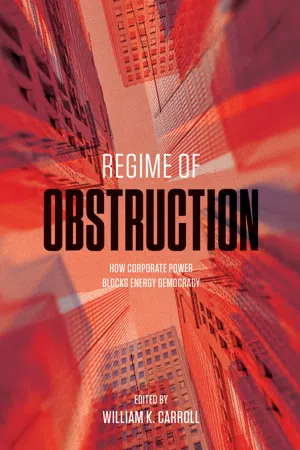
- 528 pages
- English
- ePUB (mobile friendly)
- Available on iOS & Android
About this book
Rapidly rising carbon emissions from the intense development of Western Canada's fossil fuels continue to aggravate the global climate emergency and destabilize democratic structures. The urgency of the situation demands not only scholarly understanding, but effective action.
Regime of Obstruction aims to make visible the complex connections between corporate power and the extraction and use of carbon energy. Edited by William Carroll, this rigorous collection presents research findings from the first three years of the seven-year, SSHRC-funded partnership, the Corporate Mapping Project. Anchored in sociological and political theory, this comprehensive volume provides hard data and empirical research that traces the power and influence of the fossil fuel industry through economics, politics, media, and higher education. Contributors demonstrate how corporations secure popular consent, and coopt, disorganize, or marginalize dissenting perspectives to position the fossil fuel industry as a national public good. They also investigate the difficult position of Indigenous communities who, while suffering the worst environmental and health impacts from carbon extraction, must fight for their land or participate in fossil capitalism to secure income and jobs. The volume concludes with a look at emergent forms of activism and resistance, spurred by the fact that a just energy transition is still feasible. This book provides essential context to the climate crisis and will transform discussions of energy democracy.
Contributions by Laurie Adkin, Angele Alook, Clifford Atleo, Emilia Belliveau-Thompson, John Bermingham, Paul Bowles, Gwendolyn Blue, Shannon Daub, Jessica Dempsey, Emily Eaton, Chuka Ejeckam, Simon Enoch, Nick Graham, Shane Gunster, Mark Hudson, Jouke Huizer, Ian Hussey, Emma Jackson, Michael Lang, James Lawson, Marc Lee, Fiona MacPhail, Alicia Massie, Kevin McCartney, Bob Neubauer, Eric Pineault, Lise Margaux Rajewicz, James Rowe, JP Sapinsky, Karena Shaw, and Zoe Yunker.
Frequently asked questions
- Essential is ideal for learners and professionals who enjoy exploring a wide range of subjects. Access the Essential Library with 800,000+ trusted titles and best-sellers across business, personal growth, and the humanities. Includes unlimited reading time and Standard Read Aloud voice.
- Complete: Perfect for advanced learners and researchers needing full, unrestricted access. Unlock 1.4M+ books across hundreds of subjects, including academic and specialized titles. The Complete Plan also includes advanced features like Premium Read Aloud and Research Assistant.
Please note we cannot support devices running on iOS 13 and Android 7 or earlier. Learn more about using the app.
Information
Part I
The Organization of Fossil Capital
1 Boom, Bust, and Consolidation*Corporate Restructuring in the Alberta Oil Sands
Mapping the Oligopolistic Core of the Oil Sands Industry
Assets Market capitalization (TSX ranking) | Total revenue Net incomea | Number of employees | Bitumen production capacity (bbl/d) | |
|---|---|---|---|---|
Suncor | $89,494,000,000 $84,375,452,708 (4) | $32,176,000,000 $4,458,000,000 | 12,381 | 1,175,372 (including 54% stake in Syncrude)b |
CNRL | $73,867,000,000 $55,044,350,036 (9) | $17,669,000,000 $4,640,000,000 | 9,973 | 655,500 (including 70% stake in Athabasca Oil Sands Project) |
Imperial | $41,601,000,000 $34,926,986,855 (18) | $29,125,000,000 $490,000,000 | 5,400 | 501,750 (including 25% stake in Syncrude) |
Husky | $32,927,000,000 $19,615,752,388 (34) | $18,946,000,000 $786,000,000 | 5,152 | 90,000 |
Cenovus | $40,933,000,000 $16,808,580,856 (40) | $17,314,000,000 $3,366,000,000 | 2,882 | 440,800 |
Table of contents
- Cover Page
- Title Page
- Copyright Page
- Contents
- Acknowledgements
- Introduction
- Part I. The Organization of Fossil Capital
- Part II. The Struggle for Hearts and Minds
- Part III. Resistance and Beyond
- List of Contributors